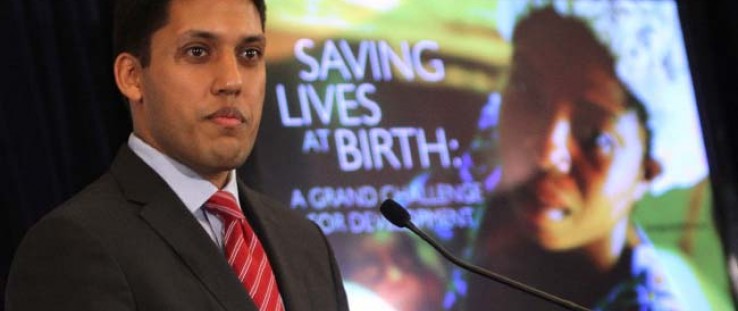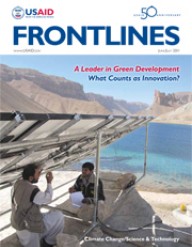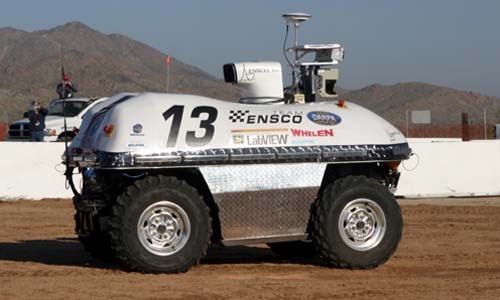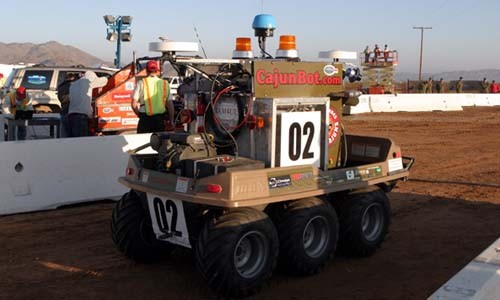 USAID Administrator Rajiv Shah delivers remarks at the March 9 launch of Saving Lives at Birth: A Grand Challenge for Development at USAID headquarters in Washington D.C.
Chris Kleponis, AFP
USAID Administrator Rajiv Shah delivers remarks at the March 9 launch of Saving Lives at Birth: A Grand Challenge for Development at USAID headquarters in Washington D.C.
Chris Kleponis, AFP
 USAID Administrator Rajiv Shah delivers remarks at the March 9 launch of Saving Lives at Birth: A Grand Challenge for Development at USAID headquarters in Washington D.C.
Chris Kleponis, AFP
USAID Administrator Rajiv Shah delivers remarks at the March 9 launch of Saving Lives at Birth: A Grand Challenge for Development at USAID headquarters in Washington D.C.
Chris Kleponis, AFP
More than a century ago, the noted German mathematician David Hilbert jotted down a list of the most compelling unsolved mathematical problems of his day. Solve these first “to lift the veil behind which the future lies hidden,” he said in 1900. Hilbert’s top picks were more than a simple “to-do” list for his mathematician buddies. They were a roll call of exactly which unsolved challenges were holding back real growth in mathematics and related disciplines.
Building on that very same idea more than 100 years later, the Bill & Melinda Gates Foundation announced a series of Grand Challenges in Global Health. The challenges were a “call for a specific scientific or technological innovation that would remove a critical barrier to solving an important health problem in the developing world with a high likelihood of global impact and feasibility.”
In short, Gates, like Hilbert, was looking for some chart-busting, best-selling, runaway successes that had eluded other problem solvers. Solving the health challenges, according to the foundation, would save millions of lives. Capitalizing on that same energy to bring about solvable solutions to today’s most daunting development problems is at the heart of USAID’s Grand Challenges for Development. But more about that later.
Agriculture’s “Top 100”
Following on the heels of Gates, a group of pre-eminent agricultural scientists, academics, and researchers identified the “top 100 questions of importance” to the future of agriculture late last year. They noted that the most pressing challenge today is how to feed almost 9 billion people by the middle of this century. These experts, writing in the well-respectedInternational Journal of Agricultural Sustainability,estimate that the world must produce 70 to 100 percent more food than it is doing now “in light of the growing impacts of climate change, concerns over energy, and regional dietary shifts.”
From a grand challenge perspective, these thought-pioneers are helping to define the new problems that must be faced, not just revisiting the decades-old goal of maximizing food productivity. In short, they are framing the next set of solvable agricultural grand challenges—like knocking down barriers to food access and distribution, minimizing volatile food price swings, and addressing dramatic changes in land use, urbanization and globalization—that will affect agricultural practices and impacts worldwide.
Grand challenges, as a term, is quite popular outside of the health and agriculture arenas and is often associated with not just one, but a series of competitions with sizable up-front cash awards. For example, the Defense Advanced Research Projects Agency (DARPA), part of the Department of Defense (DOD), has long tried to bridge the gap between innovative technologies and military use by offering big prize money to whomever can develop a long distance, off-road, driverless car seen by the DOD as vital for next-generation warfare.
And the ubiquitous photos of a bizarre array of antenna-loaded, wildly colored, robotic test vehicles bouncing mindlessly along a 150-mile test track in the Mojave Desert? DARPA’s latest grand challenge required these driverless robotic vehicles to cover a tortuous 60-mile urban track in less than six hours—and by obeying all traffic regulations. This kind of grand challenge also illustrates a known problem or goal by an organization, but an unknown, prescribed technical solution.
The First 48 Hours
Back in March, USAID launched a Grand Challenge for Development—Saving Lives at Birth, the first in a planned series that will likely also take on education, agriculture, water, and energy. Saving Lives at Birth is laser-focused on saving mothers’ and babies’ lives during their most vulnerable period—from the onset of labor until 48 hours post-delivery. Responses to the multi-donor grant program that was announced at the time of the Grand Challenge for Development has been overwhelming with more than 600 approaches from public and private sources now under review (see “Saving Lives at Birth”). And, the really big news is that close to quarter of these submissions come from developing countries themselves.
USAID’s Grand Challenges for Development (GCD) are defined in areas where the Agency believes science and technology can play a transformative role in providing solutions. This is a more open approach to solving critical barriers to development because USAID is defining problems, not solutions. Funding will be targeted to those that bring new and different ways of overcoming these critical barriers. To achieve scaled impact, the Agency will support programs that have the measurement and evaluation evidence of success in early implementations.
USAID will play an important role in elevating the focus and attention given to problem areas defined by the GCDs: convening the global community around the importance of solving the problem, sharing evidence and experiences, and fomenting solutions that work on a local level.
A successful GCD, says Alex Dehgan, director of USAID’s Office of Science and Technology, “will have a catalytic impact by facilitating and sparking the actions of others.” Not all problems will become GCDs, says Dehgan, since the Agency’s plan is to “identify only the largest, focused, solvable development problems that will be both scalable and sustainable—and have the greatest impact.”
USAID’s GCDs are a promising new way, as Hilbert might have put it, to lift the “development veil” to see a better future by mobilizing the needed global funds, intellect, innovation, and talent to improve the lives and livelihoods of the world’s poorest people.
That’s a challenge worth taking.
Saving Lives at Birth
On March 9, USAID announced its first Grand Challenge for Development—a partnership between the Agency, the Government of Norway, the Bill & Melinda Gates Foundation, Grand Challenges Canada, and the World Bank.
It was the first in what will be a series of challenges from USAID and its partners to innovative problem-solvers – this one specifically calling for solutions that focus on health interventions for pregnant women and newborns in rural, low-resource settings.
The hard facts in many developing countries: During the short window between the onset of labor and 48 hours after birth, 150,000 maternal deaths, 1.6 million neonatal deaths, and 1.2 million stillbirths occur each year.
The challenge: find groundbreaking prevention and treatment solutions.
When the submission window closed in early June, the response to “Saving Lives at Birth” surpassed expectations. More than 600 innovators submitted proposals integrating innovations across three critical areas: science and technology; creating more reliable and efficient ways to deliver health services; and innovative ideas to create demand for health services and ensure pregnant women adopt healthy behaviors.
Solutions came from for-profit companies, NGOs, academic and medical research institutions, faith-based organizations, medical associations, and foundations around the world.
USAID and its partners leveraged their collective resources and expect to provide nearly $14 million for this grant program’s first round of funding. Over five years, the partners aim to invest at least $50 million in groundbreaking and sustainable projects with the potential to have a transformative effect on the lives of pregnant women and their babies in the hardest to reach corners of the world. By leveraging global partnerships, over time the Agency believes it will be able to create scalable and sustainable solutions that will reach millions.
“Throughout history, scientific, technological and operational breakthroughs have transformed insurmountable development challenges into solvable problems,” said Alex Dehgan, the director of USAID’s Office of Science and Technology. “USAID remains committed to investing in programs that harness the collective imagination and ingenuity of experts across a broad range of disciplines and expertise to accelerate progress against maternal and newborn deaths and stillbirths at the community level.”
From July 26-28, up to 75 Grand Challenge finalists will gather in Washington, D.C., for a Development Exchange that will bring together innovators, funders, and public health experts to network and share ideas. The exchange will create an opportunity for like-minded innovators to build relationships, engage in creative problem solving, and foster collective action.












Comment
Make a general inquiry or suggest an improvement.